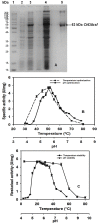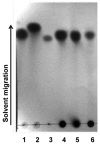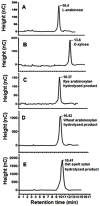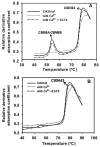A novel α-L-arabinofuranosidase of family 43 glycoside hydrolase (Ct43Araf) from Clostridium thermocellum
- PMID: 24039988
- PMCID: PMC3767815
- DOI: 10.1371/journal.pone.0073575
A novel α-L-arabinofuranosidase of family 43 glycoside hydrolase (Ct43Araf) from Clostridium thermocellum
Abstract
The study describes a comparative analysis of biochemical, structural and functional properties of two recombinant derivatives from Clostridium thermocellum ATCC 27405 belonging to family 43 glycoside hydrolase. The family 43 glycoside hydrolase encoding α-L-arabinofuranosidase (Ct43Araf) displayed an N-terminal catalytic module CtGH43 (903 bp) followed by two carbohydrate binding modules CtCBM6A (405 bp) and CtCBM6B (402 bp) towards the C-terminal. Ct43Araf and its truncated derivative CtGH43 were cloned in pET-vectors, expressed in Escherichia coli and functionally characterized. The recombinant proteins displayed molecular sizes of 63 kDa (Ct43Araf) and 34 kDa (CtGH43) on SDS-PAGE analysis. Ct43Araf and CtGH43 showed optimal enzyme activities at pH 5.7 and 5.4 and the optimal temperature for both was 50°C. Ct43Araf and CtGH43 showed maximum activity with rye arabinoxylan 4.7 Umg(-1) and 5.0 Umg(-1), respectively, which increased by more than 2-fold in presence of Ca(2+) and Mg(2+) salts. This indicated that the presence of CBMs (CtCBM6A and CtCBM6B) did not have any effect on the enzyme activity. The thin layer chromatography and high pressure anion exchange chromatography analysis of Ct43Araf hydrolysed arabinoxylans (rye and wheat) and oat spelt xylan confirmed the release of L-arabinose. This is the first report of α-L-arabinofuranosidase from C. thermocellum having the capacity to degrade both p-nitrophenol-α-L-arabinofuranoside and p-nitrophenol-α-L-arabinopyranoside. The protein melting curves of Ct43Araf and CtGH43 demonstrated that CtGH43 and CBMs melt independently. The presence of Ca(2+) ions imparted thermal stability to both the enzymes. The circular dichroism analysis of CtGH43 showed 48% β-sheets, 49% random coils but only 3% α-helices.
Conflict of interest statement
Figures






References
-
- Harris PJ, Stone BA (2009) Chemistry and molecular organization of plant cell walls. In: Biomass recalcitrance: deconstructing the plant cell wall for bioenergy (ed. Himmel ME), Blackwell Publishing Ltd: Oxford, UK. 61–93.
-
- Saha BC (2003) Hemicellulose bioconversion J Ind Microbiol Biotechnol. 30: 279–291. - PubMed
-
- Ordaz-Ortiz JJ, Saulnier L (2005) Structural variability of arabinoxylans from wheat flour, comparison of water-extractable and xylanase-extractable arabinoxylans J Cereal Sci. 42: 119–125.
-
- Bengtsson S, Aman P, Andersson RE (1992) Structural studies on water-soluble arabinoxylans in rye grain using enzymatic hydrolysis Carbohyd Polym. 17: 277–284.
-
- Gruppen H, Hamer RJ, Voragen AGJ (1992) Water-unextractable cell-wall material from wheat-flour, fractionation of alkali-extracted polymers and comparison with water-extractable arabinoxylans J Cereal Sci. 16: 53–67.
Publication types
MeSH terms
Substances
LinkOut - more resources
Full Text Sources
Other Literature Sources
Molecular Biology Databases
Miscellaneous

